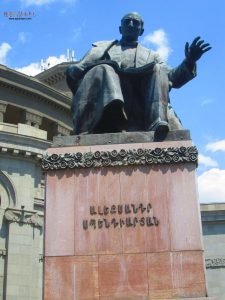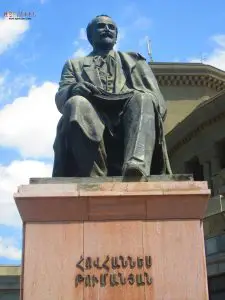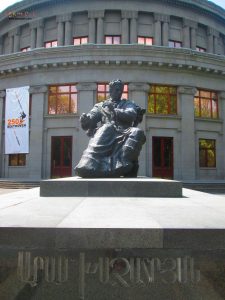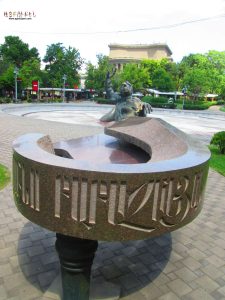| Previous Name | Zhoghtun, 1926 |
| Construction started | 1932 |
| Opening date | January 20th, 1933 |
| Architect | Alexander Tamanyan |
| Number of Halls | 2 |
| Capacity – Aram Khachaturyan Concert Hall | 1400 seats |
| Capacity – Alexander Spendiaryan Opera & Ballet National Theater | 1200 seats |
| First Opera Performance | Almast by Alexander Spendiaryan. 1933 |
| First Ballet Performance | Swan Lake by Pyotr Tchaikovsky. 1935 |
Location (How to Get there) Opera House in Yerevan.
The Armenia Opera House is located in the heart of Yerevan next to France Square when approached from the Cascade complex. You can reach The Armenian Opera House by taking The Yerevan metro or just walking down Abovyan Street and turning right on Sayat Nova Ave. or Tumanyan street.
When was the Armenian Theatre of Opera and Ballet Built?
As for the Opera building itself, it was officially opened on January 20th, 1933. With Alexander Spendiaryan’s ‘Almast’ opera performance.
Having been designed by the Armenian architect Alexander Tamanyan, the building has two concert halls: – the Aram Khachaturyan Concert Hall with 1,400 seats.
– the Alexander Spendiaryan Opera and Ballet National Theater with 1,200 seats.
‘Swan Lake’ by the Russian composer Pyotr Tchaikovsky was the first ballet performance to take place here in 1935.
That is probably the reason why the artificial lake in the neighborhood is called Swan Lake.
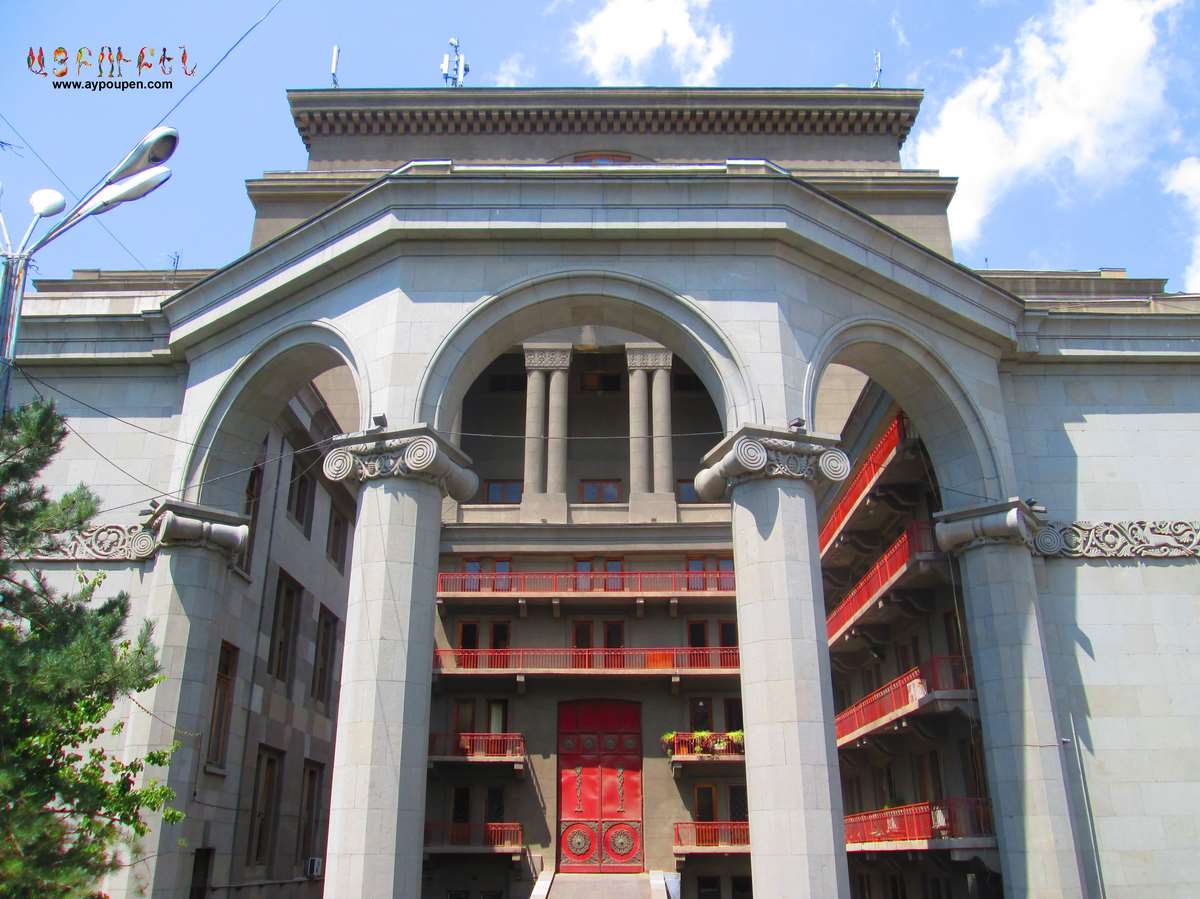
Surroundings of Yerevan Opera House
Swan Lake (Artificial)
The lake has a shape similar to that of ‘Armenia’s blue pearl,’ Lake Sevan.
The Swan Lake was constructed in 1963 and occupied an area of 2,490m2. Since 2005 one part of it, an area of 1,200 m2, has been turned into an open-air skating rink in winters. If you skate with your own skates, the rent is 500 AMD (app. $1) per hour, and if you need to rent them as well, you will have to pay 1,000 AMD (app. $2) per hour.
Video Tour Around Opera & Ballet Theater
The Freedom Square
Freedom Square was surrounded by many open-air cafés until the velvet revolution in 2018. However, with the new government coming to power, some of the open-air cafes were uninstalled and replaced by newly planted trees instead.
5 Statues You Should See Around the Opera & Ballet Theatre House
It is not a secret that Armenians like honoring their great people by placing their statues or monuments dedicated to their works of art. You can see at least one statue on each street, whether big and well-seen or small, disguised in the bushes or behind trees.
In the neighborhood of Freedom Square, where there is the Armenian National Academic Theater of Opera and Ballet after Alexander Spendiaryan, or simply Opera, five big statues can be seen: Alexander Spendiaryan’s, Hovhannes Tumanyan’s, Aram Khachaturyan’s, Arno Babajanyan’s statues and one called ‘Melody’ depicting a sitting girl playing the lyre.
Many people visit Freedom Square: some come here to play volleyball or football, some like sitting and watching others play, some show their roller-skating talent or bicycle riding skills, and some others just cut their way short through the square.
However, many people do not know to who all these statues are dedicated, especially those visiting Armenia for the first time.
Let us find out together who these great Armenians were and why they deserved the right to still be among us.
Alexander Spendiaryan and Hovhannes Tumanyan’s Statues (AKA The Twins)
These two statues are sometimes referred to as the twin statues since they were placed in the square at the same time (in 1957), and, at first glance, they seem to have no differences.
Alexander Spendiaryan
Born November 1, 1871, Kakhovka – Died May 7, 1928, Yerevan
Spendiaryan was a Russian and Soviet music composer, conductor, and founder of Armenian national symphonic music.
The Opera and Ballet Theater located behind him carries his name. Looking at his proud statue, one feels as if he is sitting there and still composing some new pieces of music for us.
Some of Spendiaryan’s well-known works are ‘Enzeli’, ‘Ghaytarma’ (Crimean Dance), ‘The Same Night’, and others.
The statue is made of bronze and granite.
Hovhannes Tumanyan
February 19, 1869, Lori Province- March 23, 1923, Moscow
Hovhannes Tumanyan was an Armenian poet, writer, translator, and literary and public activist. Many films and animated films have been adapted from Tumanyan’s works. The operas ‘Anush’ (1912) by Armen Tigranyan, and ‘Almast’ (1930) by Alexander Spendiaryan, were written based on his works.
Hovhannes Tumanyan was one of the few writers writing fables mainly for adults and is loved by all age groups. The writer especially introduced village life and nature in Armenia in his works.
Every year Hovhannes Tumanyan’s birthday is celebrated on February 19th by giving each other books and organizing different events dedicated to the writer’s memory.
Tumanyan was a man of many great talents. Apart from writing, he is also the creator of several board games now sold in his museum at the end of Tumanyan Street.
His statue depicts Tumanyan sitting while holding a book as if getting ready to read his fables to us. The statue is made of bronze and granite.
Aram Khachaturyan: Armenia’s “National Treasure”
Aram Khachaturyan 24 May 1903 – 1 May 1978. His statue was placed in front of the Opera in 1999. He was a Soviet Armenian composer and conductor.
He composed the first Armenian ballet music, symphony, concerto, and film score. Aram Khachaturyan is considered the most renowned composer of the 20th century.
He has composed for ballets, orchestras, and not only.
His two compositions, ‘Gayane’ and ‘Spartacus,’ are considered the most successful ones. ‘The Saber Dance’ from Gayane has been played in all parts of the world.
The philharmonic hall of the Yerevan Opera Theater has been officially called the Aram Khachaturyan Grand Concert Hall since 1978. Aram Khachaturyan’s statue is made of bronze and granite.
Arno Babajanyan
Arno Babajanyan, January 22, 1921 – November 11, 1983
The latest statue that was placed in the neighborhood of the Freedom Square is that of Arno Babajanyan – another Soviet Armenian composer and pianist.
People disapproved of the statue when it was first placed in September 2002, claiming that it was too ugly and more like a fun caricature of the composer.
The statue was removed and placed back after some more work had been done on it by the sculptor, Davit Bejanyan. It was officially unveiled on July 4th, 2003.
Arno Babajanyan’s songs can be heard in many films. He has composed over 200 songs, among them ‘Beautiful Girl of Yerevan’ («Երևանի սիրուն աղջիկ»), ‘Elegy’, ‘Wonderful Dream’ («Չքնաղ երազ») and others. The statue is made of bronze and granite.
The ‘Melody’ Statue: the Mysterious Girl Playing the Lyre
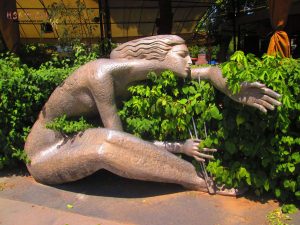
Not much is known about this statue, unfortunately. Probably only it was placed in the Swan Lake in 1965, and its sculptor was Sargis Baghdasaryan.
The latter was a Soviet Armenian sculptor best known for his 1967 work called ‘We Are Our Mountains,’ which is a monument carved into a tuff volcanic stone north of Stepanakert, the capital of Artsakh.
The monument is also called ‘Tatik Papik’ monument by the locals as an old man and woman are depicted.
We used to play by ‘Melody statue’ as kids and sometimes even hug her like an old dear friend. It seemed as if we could actually hear the girl play some wonderful music, the music of our childhood. The ‘Melody’ statue is made of aluminum and granite.
When was the Opera House Found?
Many will testify that the Armenian National Academic Theatre of Opera and Ballet is the heart and soul of Yerevan. Still, very few people know the history of this architectural masterpiece.
In 1927, the Opera Studio was founded on the initiative of A. Ter-Ghevondyan, the director of the Yerevan State Conservatory, and in 1932, the Opera House was established by the decision of the Government of the Armenian SSR.
Initially, it operated in the building of the Yerevan Workers’ Drama Theatre (the current building of the Stanislavsky Russian Theatre), and from 1940, in the building designed by Alexander Tamanian.
Who Built the Armenian Theatre of Opera and Ballet
In A. Tamanian’s huge legacy, the House of Theatre of Opera and Ballet project was his favorite and most cherished. Simultaneously, no other structure caused him so much trouble and bitterness or required such a strain of mental and physical exhaustion as the building of the Opera House, or Zhoghtun, as it was previously called.
In March of 1923, returning to Yerevan, he assumed several positions and became one of the construction directors of the republic. In January 1926, the Transcaucasian Central Executive Committee decided to build Zhoghtun in Yerevan with a theater and some seats following the city’s requirements. Project implementation and construction management were assigned to A. Tamanian.
He thought that it was necessary to hold a contest before designing such an important public structure for Zhoghtun. It had to clarify the architectural approaches to the image of the building, style, role of urban development, size, functional organization, and other architectural issues.
Zhoghtun Construction Committee agreed with Tamanian and, in May 1926, announced a contest. It was the first major architectural competition held in Soviet Armenia. His program was made by himself – A. Tamanian in Russian.
According to the program, the complex included all the necessary spaces for Zhoghtun in the future: a theater for 1200 spectators, a concert hall, auditoriums, a library with a reading room, exhibition halls, group training rooms, and a cafeteria.
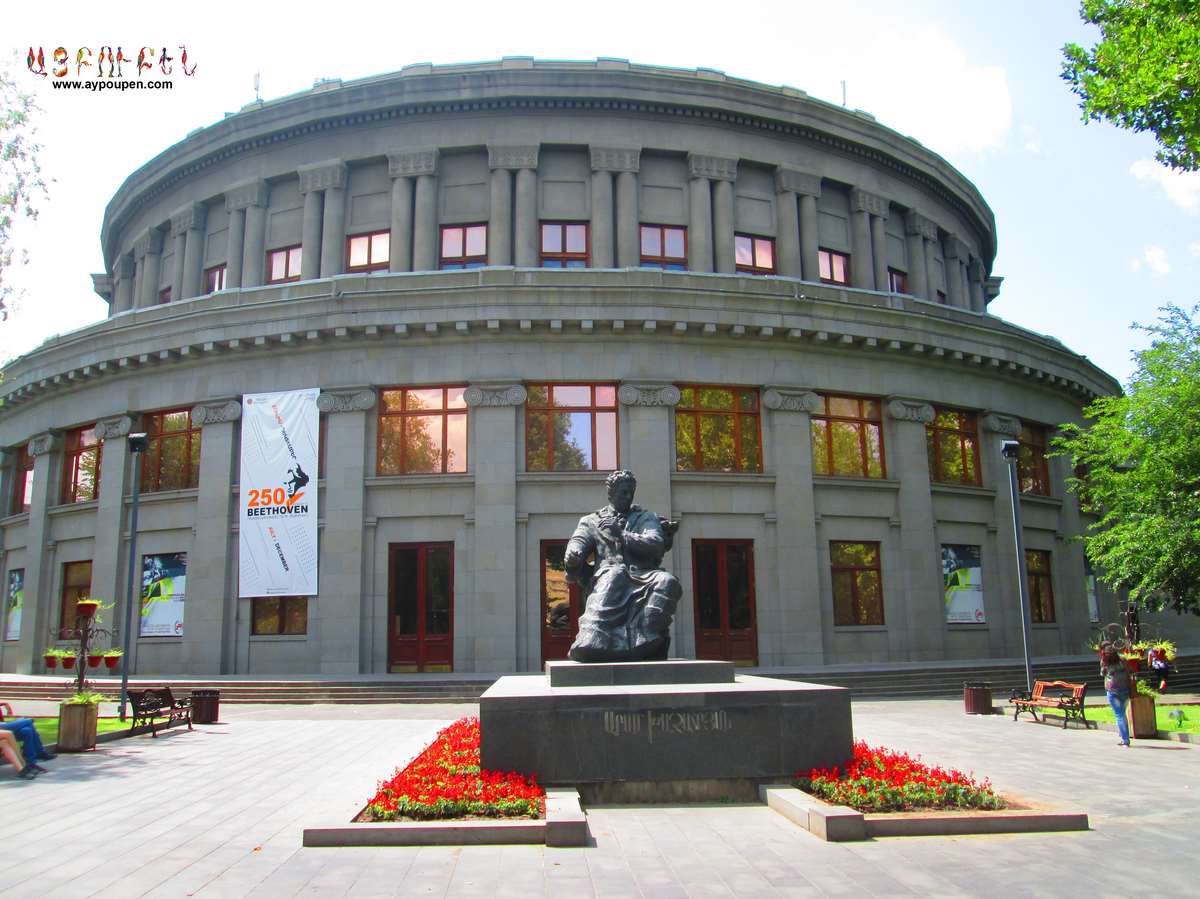
Planning & Upgrades of Yerevan’s Theatre of Opera and Ballet
Starting the project and continuously improving it, Tamanian tried to implement a house of Theatre of Opera and Ballet that meets all the latest requirements, content, and architectural solution that would correspond to the capital.
He planned a two-hall building with one common big stage. Tamanian has envisaged two equal halls, which can operate both separately and, if necessary, by joining together. The difference between the halls is that one is winter, closed on all sides (1500 seats), and the other is summer (1200 seats). The summer hall had more options.
In the first version, there was no roof, then the roof was added, and there were no walls but columns. The idea of a summer hall came from the warm climate of Yerevan. It did not even have a foyer. During the breaks, the spectators would go out to the park.
How did the Opera House move from the Suburbs of Yerevan into the Center?
The construction site of Zhoghtun was determined by the general plan of Yerevan. It was hard for the people of Yerevan to imagine that this suburban place would become a part of the future Yerevan Public Centre.
In parallel with the design, Tamanian had to solve three issues related to the land plot for the building: alienation of gardens from the owners, transportation of the ”Mamri” irrigation water pipeline, and the fate of the ”Gethsemane” Chapel.
The most painful question was one about the Gethsemane Chapel. According to the New Testament, Gethsemane was a place of olive groves, where Christ had offered his last prayers before being crucified. The chapel was given that name probably because it was located in the gardens. It was built in 1679 on the site of an older church destroyed by an earthquake.
The chapel was single-nave, vaulted, small, and dome-shaped. Tamanian decided to move it. Therefore, in 1929 they demolished and numbered the stones one by one. However, one of the frequently changing construction directors used the chapel’s stones to construct a residential house for Zhoghtun workers on Byron Street.
Vigen Zakaryan
The son of builder Vardan Zakaryan, says that his father was only 23 years old. Still, during his years at the House of Theatre of Opera and Ballet, he was eventually promoted from an ordinary technician and became the deputy head of construction. He remembers his father saying that Alexander Tamanian was very careful about construction.
Tamanian often approached Vigen’s father at the construction site and said: “Dear Vardan, let’s go and see if the sand is washed or not.” Tamanian wanted to make sure that the concrete foundation of the opera house was made of solid mortar, he was worried that the building would not suddenly suffer from possible earthquakes.
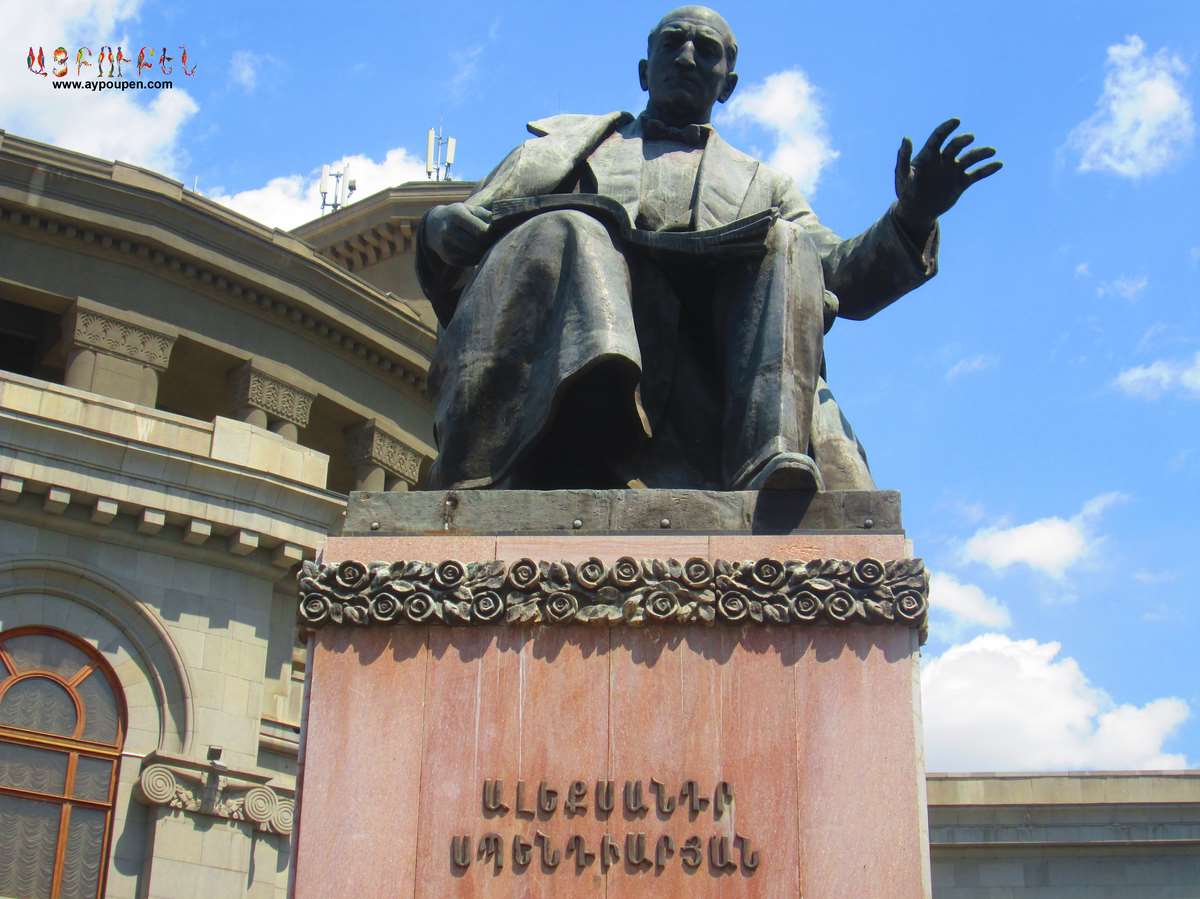
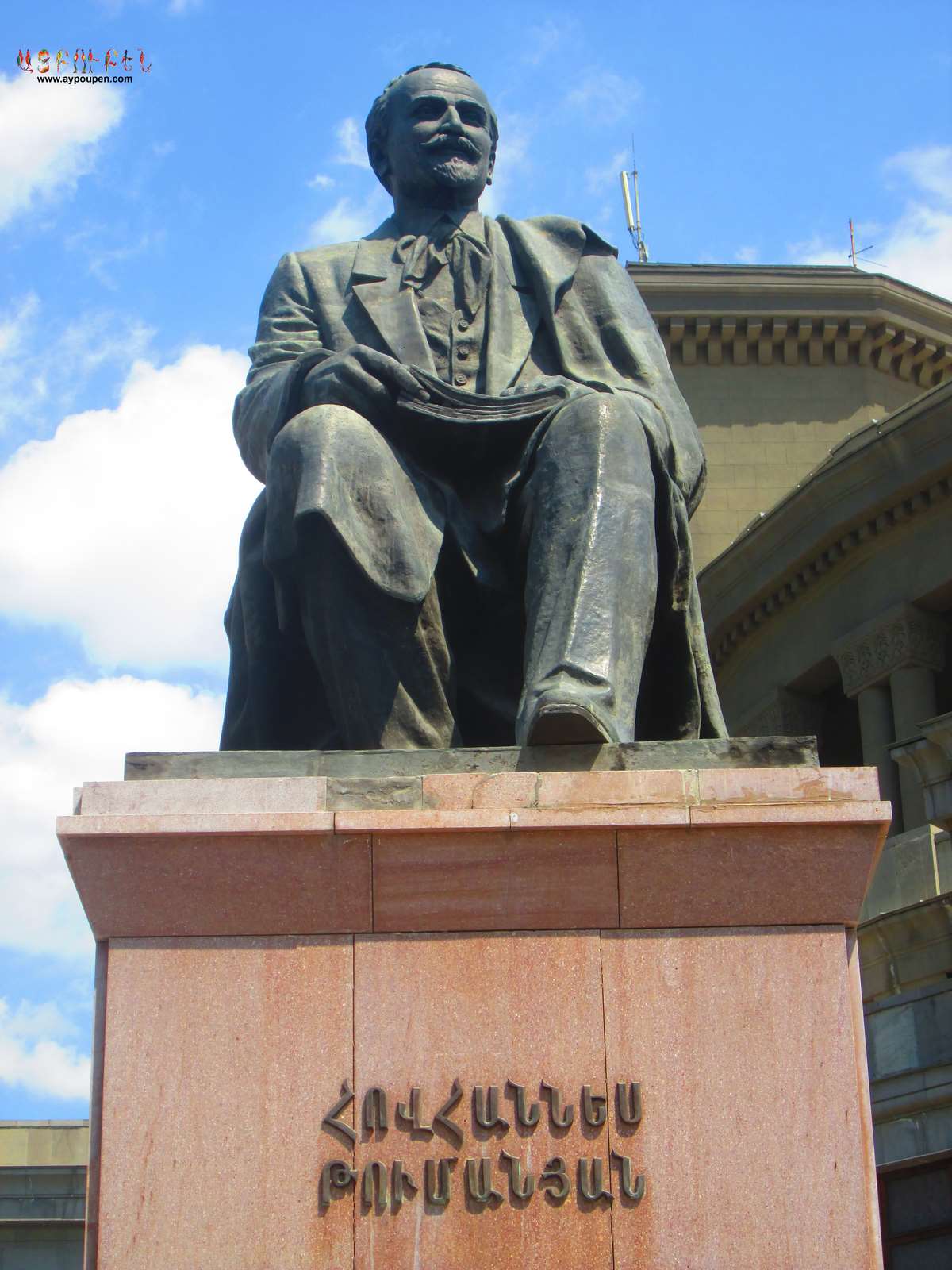
You may ask why their statues are in front of the opera building. The answer is that the first opera performance named “Almast” was written by the composer Spendiaryan (it is also why the building is named in honor of him).
In his turn, Tumanyan is the author of the poem ”Anush”, which was later used in the famous opera of the same name composed by Armen Tigranian.
Anna Sargsyan
In front of the National Theatre of Opera and Ballet building, you can see two sculptures of outstanding people they are:
Aleksander Spendiaryan – music composer, conductor, founder of Armenian national symphonic music
Hovhannes Tumanyan – Armenian poet, writer, and translator.
Anna Sargsyan, the granddaughter of sculptor Ara Sargsyan, says that when Ara Sargsyan lived in Paris, he received a letter from Martiros Saryan. The master suggested Ara move to Yerevan to develop monumental sculptures in Armenia.
In 1938, her grandfather participated in the All-Union Competition to create a Statue of Hovhannes Tumanyan. He made two versions: plaster and wood, which differed from each other in terms of composition.
In the first version, Tumanyan was standing. In the second, sitting in an armchair. It was planned that there would be bas-reliefs on the pedestal, based on Tumanyan’s works, but that idea did not materialize. Spendiarov is also depicted sitting. There are notes on his knees, and his left hand seems to respond to the music.
Her grandfather tried to portray the composer in a moment of creative inspiration. Ara Sargsyan worked together with Ghukas Chubaryan on that statue. By the way, back in 1928, he also made Spendiaryan’s posthumous mask.
The Unique Chandelier of the Armenian Opera and Ballet House Theatre

In 1980, the 60th anniversary of the Armenian SSR was to be celebrated. About a year before that, the National Academic Theatre of Opera and Ballet building began to be renovated. A competition was announced to make a new chandelier. About 200 architects and painters took part in the competition.
No project was recognized as a winner in the first round of the competition. The projects of about 30 participants who passed the second round were not approved either. Finally, eight months before the date, the third round of the competition was announced.
Then Leon Karsyan decided to try himself. He presented the illuminated model of the chandelier, which was approved and declared the winner.
The chandelier was moved to the hall in parts and placed on the ceiling with the help of special equipment. In the process, some technical problems arose: the torch barely escaped falling.
The large central chandelier of the hall has a diameter of about 8 meters, a height of about 6 meters, and weighs 5 tons. Real gold was used in the process of preparing it.
The big chandelier of the opera house is washed once every 3-4 years, the small chandeliers around it once a year.
The process of washing the chandelier is supervised by the chief engineer of the theater Artavazd Amirkhanyan. 6-7 employees take part in the washing process. No special materials are used during washing.
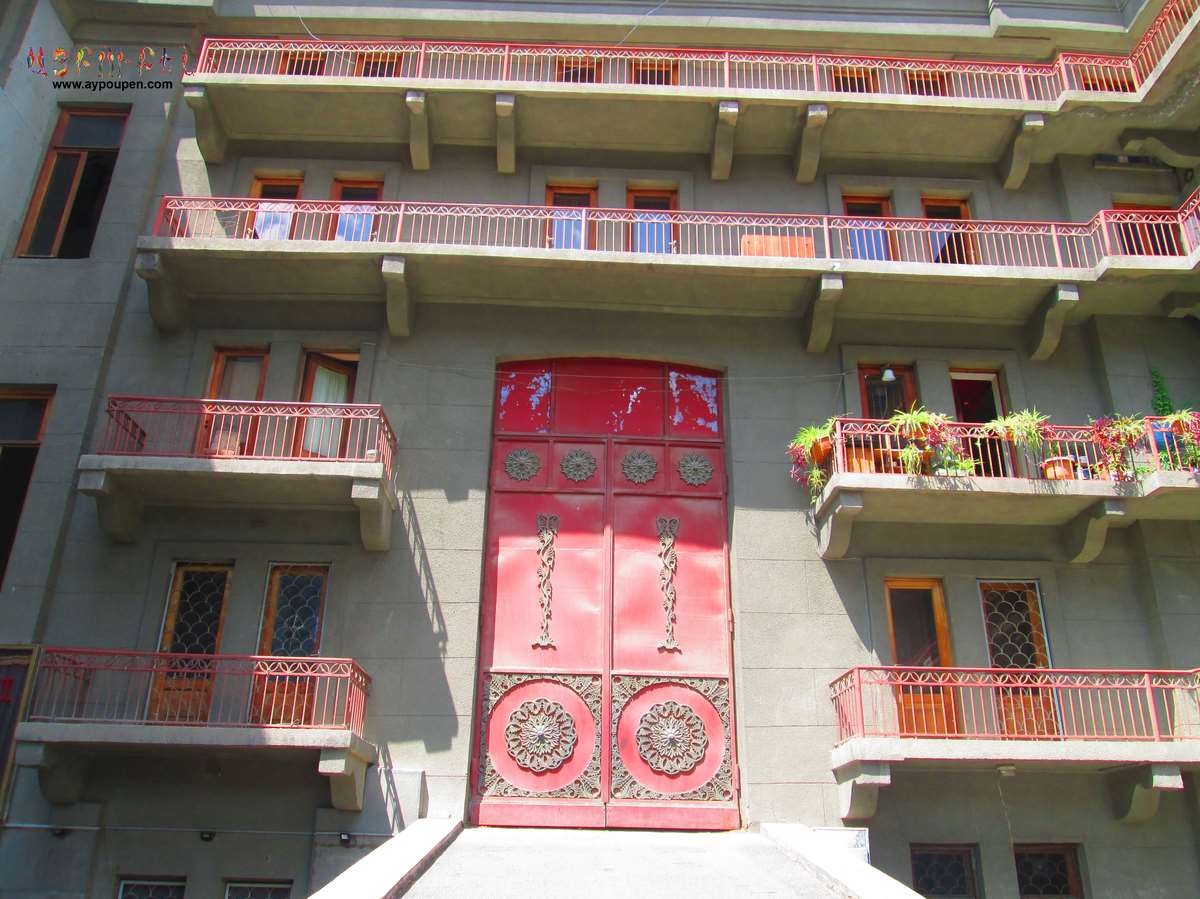

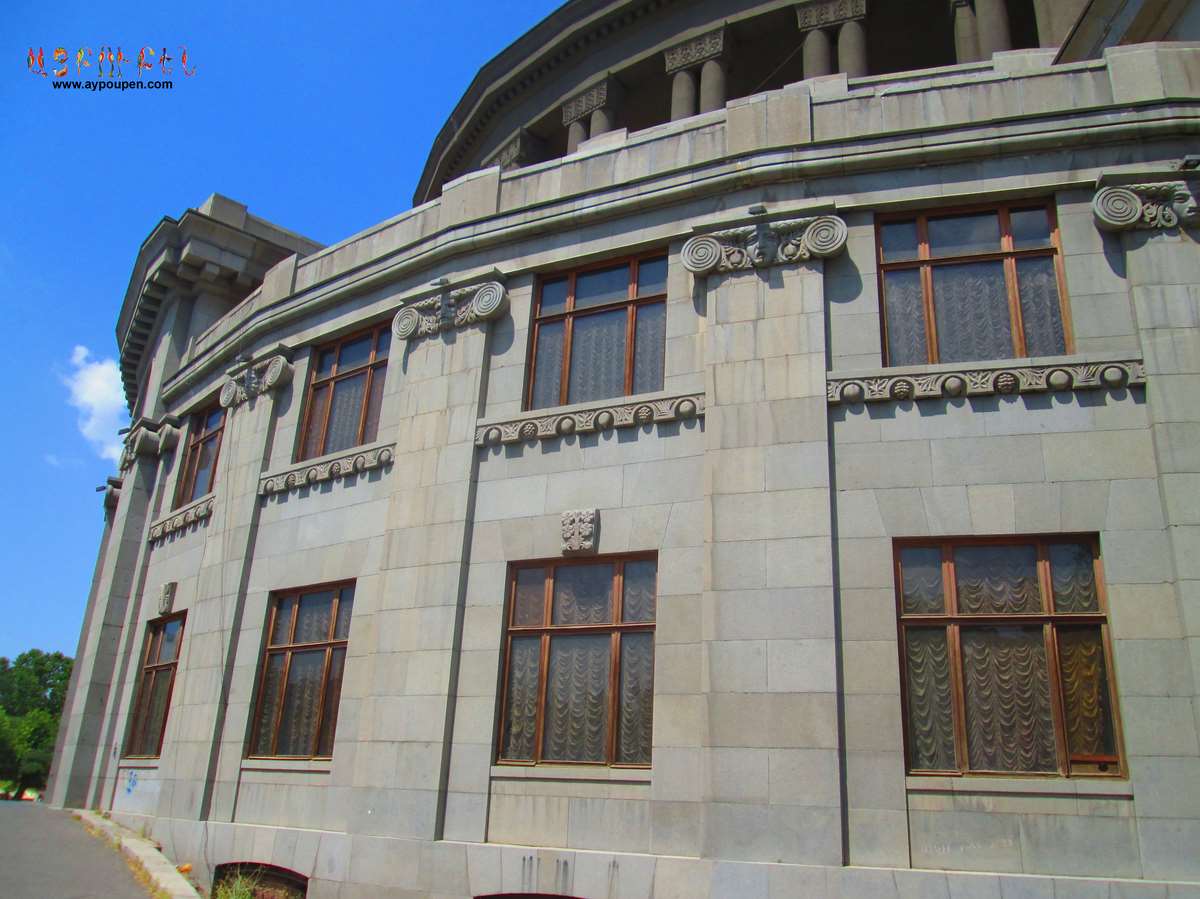
What do People say about the Opera House in the Heart of Yerevan?
Retired Emma Davtyan
Says that they did not attend the Theatre of Opera and Ballet in their everyday clothes. Even if they knew they would sit on the steps, they still wore evening dresses. People had holiday clothes that they only wore when they went to the Opera. The same goes for shoes. She had high-heeled shoes specifically for going to the Opera.
Narek Avetisyan
The son of famous painter Minas Avetisyan, says that in the 1960s, 2-3 years after Minas returned from Leningrad, the famous choreographer Yevgeny Changa invited him to the Opera House to design the performances.
Minas became a revelation for the theater with his innovative approach. Among his works are the designs of “Antuni” ballet oratorio, “Bolero,” “Sako from Lori,” “Cinderella,” “Almast” ballet, and, of course, “Gayane” ballet.
Aram Khachaturian
He wished that Minas would design the “Gayane” ballet. However, in the beginning, there were disagreements between them. Aram Ilyich said that the colors are too much and bright, to which Minas replied that he does not go far from the composer’s music. Khachaturian later admitted that Minas’ design was completely in tune with the music he created.
Conclusion
The Opera remains to be one of the most favorite places of all Yerevan residents and visitors. If you happen to pass by, make sure to approach each statue and listen carefully
– you will definitely hear the great composers’ works, Hovhannes Tumnyan’s great poems, and fables, and, of course, the mysterious girl will play something divine for you to make sure you will visit again.
Hundreds of stories and memories are related to the historical event of building the Armenian National Academic Theatre of Opera and Ballet after A. Spendiaryan. Each story gives its unique flour to the Opera House and makes us walk parallel with the history daily when we pass by that building.
If you like this article and would like to be updated when we publish a new one,
please follow us on Aypoupen Instagram ,
,
and like our Aypoupen Facebook page
and subscribe to our Aypoupen Youtube channel .
.

